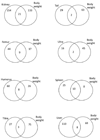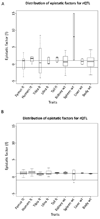Evolution of pleiotropy: epistatic interaction pattern supports a mechanistic model underlying variation in genotype-phenotype map
- PMID: 21462316
- PMCID: PMC3112255
- DOI: 10.1002/jez.b.21410
Evolution of pleiotropy: epistatic interaction pattern supports a mechanistic model underlying variation in genotype-phenotype map
Abstract
The genotype-phenotype (GP) map consists of developmental and physiological mechanisms mapping genetic onto phenotypic variation. It determines the distribution of heritable phenotypic variance on which selection can act. Comparative studies of morphology as well as of gene regulatory networks show that the GP map itself evolves, yet little is known about the actual evolutionary mechanisms involved. The study of such mechanisms requires exploring the variation in GP maps at the population level, which presently is easier to quantify by statistical genetic methods rather than by regulatory network structures. We focus on the evolution of pleiotropy, a major structural aspect of the GP map. Pleiotropic genes affect multiple traits and underlie genetic covariance between traits, often causing evolutionary constraints. Previous quantitative genetic studies have demonstrated population-level variation in pleiotropy in the form of loci, at which genotypes differ in the genetic covariation between traits. This variation can potentially fuel evolution of the GP map under selection and/or drift. Here, we propose a developmental mechanism underlying population genetic variation in covariance and test its predictions. Specifically, the mechanism predicts that the loci identified as responsible for genetic variation in pleiotropy are involved in trait-specific epistatic interactions. We test this prediction for loci affecting allometric relationships between traits in an advanced intercross between inbred mouse strains. The results consistently support the prediction. We further find a high degree of sign epistasis in these interactions, which we interpret as an indication of adaptive gene complexes within the diverged parental lines.
Copyright © 2011 Wiley-Liss, Inc., A Wiley Company.
Figures




References
-
- Barret RDH, Rogers SM, Schluter D. Environment specific pleiotropy facilitates divergence at the ectodysplasin locus in threespine stickleback. Evolution. 2009;63:2831–2837. - PubMed
-
- Beldade P, French V, Brakefield PM. Developmental and genetic mechanisms for evolutionary diversification of serial repeats: eyespot size in Bicyclus anynana butterflies. J Exp Zool B (Nol Dev Evol) 2008;310B:191–201. - PubMed
Publication types
MeSH terms
Grants and funding
LinkOut - more resources
Full Text Sources

